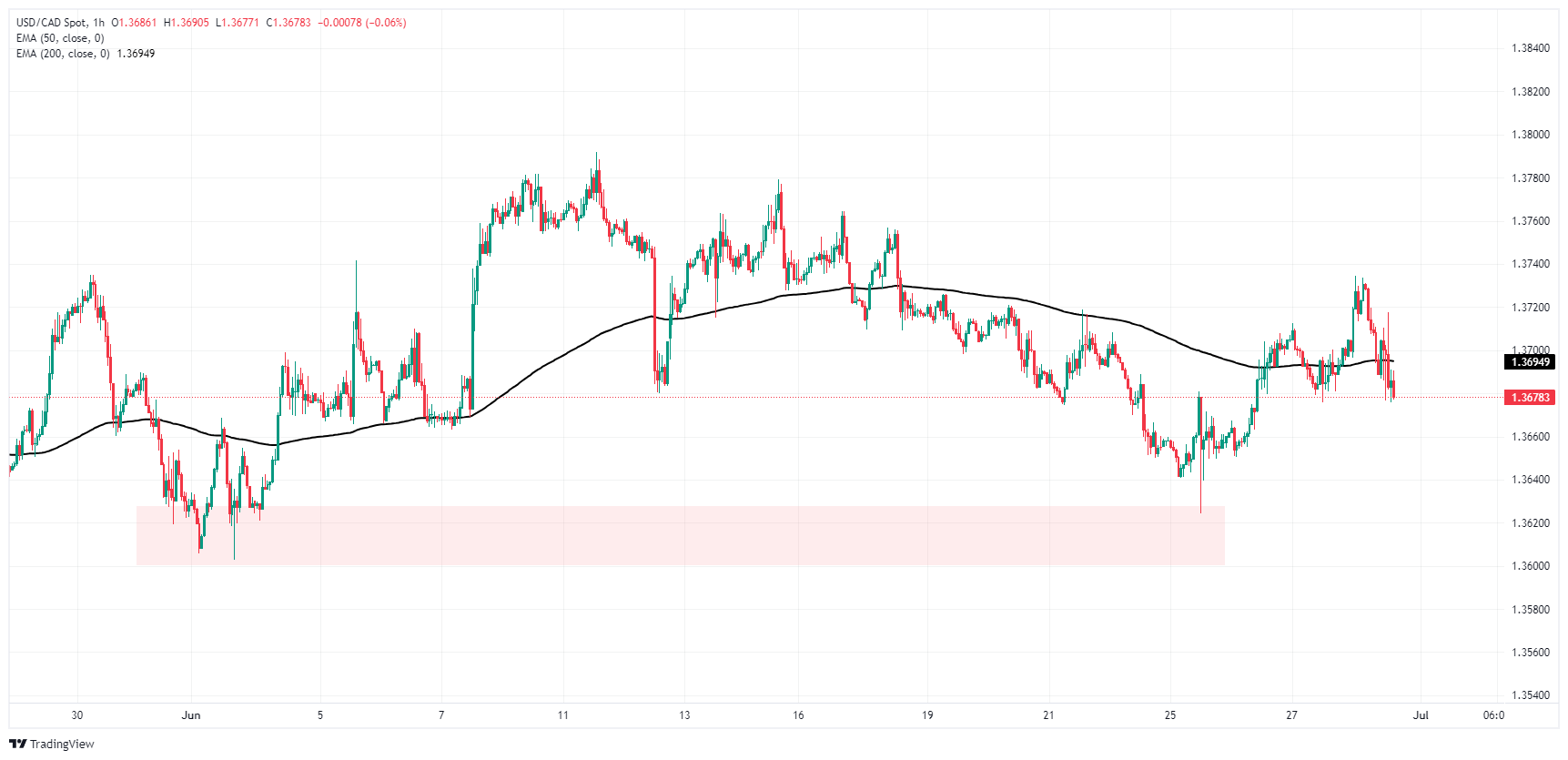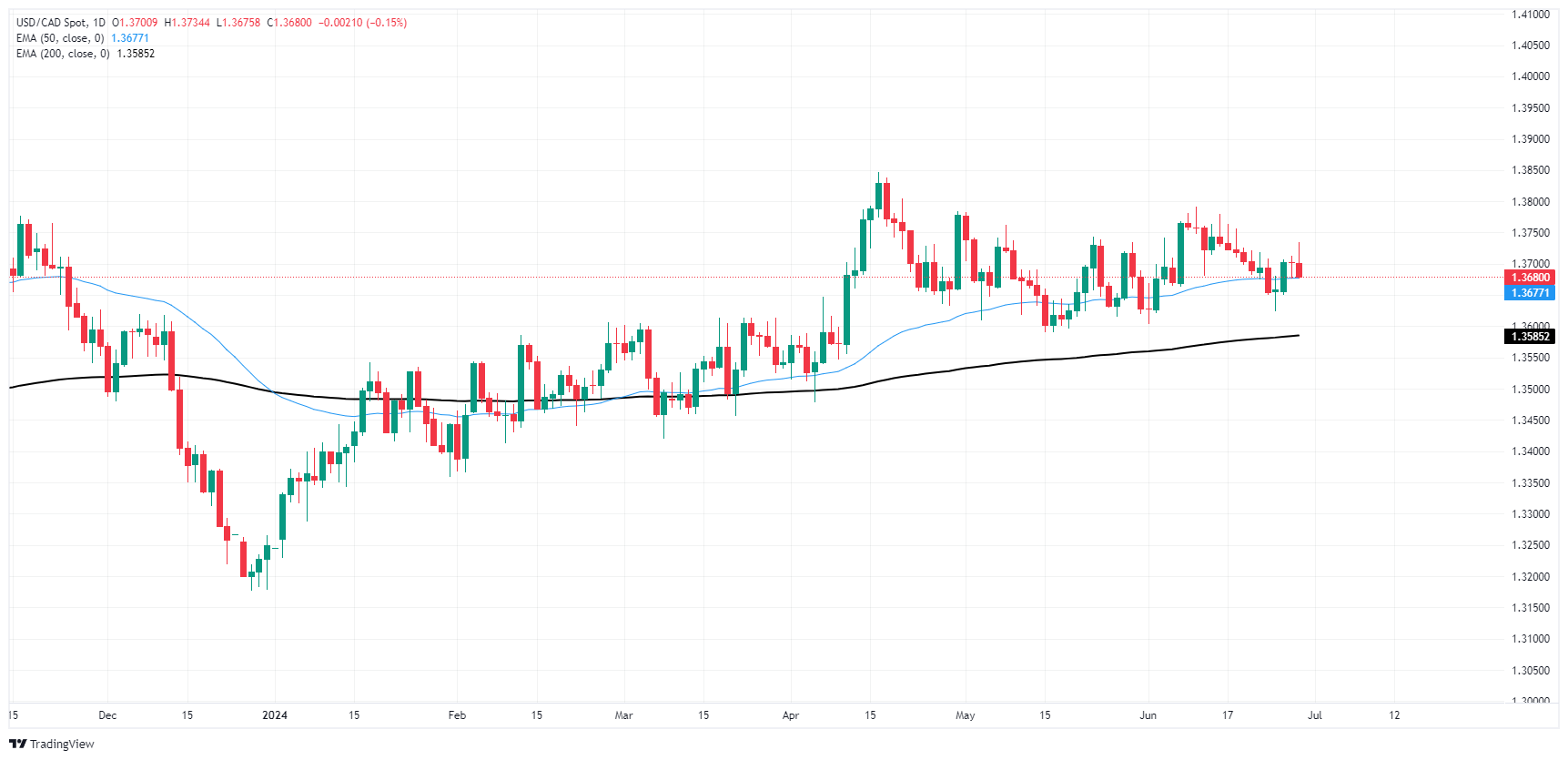- Analytics
- News and Tools
- Market News
- Canadian Dollar gains ground after Canadian GDP steps higher
Canadian Dollar gains ground after Canadian GDP steps higher
- Canadian Dollar bolstered by rising market sentiment.
- Canada posted a 0.3% uptick in GDP, propping up CAD.
- US PCE inflation also ticked lower, further bolstering rate cut hopes.
The Canadian Dollar (CAD) found some room on the high side on Friday, pushing up by a scant tenth of a percent against the US Dollar amid choppy intraday price action after key economic data broadly met market expectations. Canadian Gross Domestic Product (GDP) ticked higher and US Personal Consumption Expenditure Price Index (PCE) inflation figures cooled slightly.
Canada posted a slight gain in GDP growth in April, rebounding from the previous month’s flat print. A stacked US data docket also generally met market expectations, though US Personal Spending failed to meet expectations despite a post-revision improvement.
Daily digest market movers: Canadian GDP rebounds, US inflation continues to ease for now
- Canadian MoM GDP posted a 0.3% increase in April, meeting market expectations and recovering from the previous month’s 0.0%.
- US PCE Price Index inflation also eased to 2.6% YoY in May, meeting market forecasts and cooling from the previous 2.8%.
- Market bets of a September rate cut from the Federal Reserve (Fed) have ticked higher post-PCE. According to the CME’s FedWatch Tool, rate markets are pricing in 66% odds of at least a quarter-point rate trim from the Fed on September 18, up from a flat 60% pre-PCE inflation.
- University of Michigan (UoM) 5-year Consumer Inflation Expectations also ticked down to 3.0% in June, down from previous 3.1%.
- UoM Consumer Sentiment Index for June also surged to 68.2 from 65.6, vaulting over median market forecasts of 65.8.
Canadian Dollar PRICE Today
The table below shows the percentage change of Canadian Dollar (CAD) against listed major currencies today. Canadian Dollar was the strongest against the Japanese Yen.
| USD | EUR | GBP | JPY | CAD | AUD | NZD | CHF | |
|---|---|---|---|---|---|---|---|---|
| USD | -0.15% | -0.02% | 0.03% | -0.14% | -0.41% | -0.20% | -0.01% | |
| EUR | 0.15% | 0.12% | 0.17% | 0.00% | -0.27% | -0.06% | 0.13% | |
| GBP | 0.02% | -0.12% | 0.02% | -0.13% | -0.39% | -0.18% | -0.02% | |
| JPY | -0.03% | -0.17% | -0.02% | -0.19% | -0.44% | -0.24% | -0.05% | |
| CAD | 0.14% | -0.01% | 0.13% | 0.19% | -0.28% | -0.06% | 0.10% | |
| AUD | 0.41% | 0.27% | 0.39% | 0.44% | 0.28% | 0.21% | 0.38% | |
| NZD | 0.20% | 0.06% | 0.18% | 0.24% | 0.06% | -0.21% | 0.16% | |
| CHF | 0.01% | -0.13% | 0.02% | 0.05% | -0.10% | -0.38% | -0.16% |
The heat map shows percentage changes of major currencies against each other. The base currency is picked from the left column, while the quote currency is picked from the top row. For example, if you pick the Canadian Dollar from the left column and move along the horizontal line to the US Dollar, the percentage change displayed in the box will represent CAD (base)/USD (quote).
Technical analysis: Canadian Dollar recovers ground on Friday, sends USD/CAD into familiar levels
The Canadian Dollar found a bid on Friday, gaining ground against the majority of its major currency peers as markets get set to wrap up a relatively sedate trading week. The CAD gained around one-tenth of one percent against the US Dollar on Friday and climbed nearly one-quarter of one percent against the broadly-battered Japanese Yen.
USD/CAD briefly found a fresh high for the week near 1.3735 early Friday before settling back into familiar near-term lows near 1.3675. CAD strength has briefly halted a recent upswing in the pair on a Greenback bid, sending USD/CAD into a rough near-term corkscrew around the 200-hour Exponential Moving Average (EMA) near the 1.3700 handle.
USD/CAD hourly chart
USD/CAD daily chart
Canadian Dollar FAQs
The key factors driving the Canadian Dollar (CAD) are the level of interest rates set by the Bank of Canada (BoC), the price of Oil, Canada’s largest export, the health of its economy, inflation and the Trade Balance, which is the difference between the value of Canada’s exports versus its imports. Other factors include market sentiment – whether investors are taking on more risky assets (risk-on) or seeking safe-havens (risk-off) – with risk-on being CAD-positive. As its largest trading partner, the health of the US economy is also a key factor influencing the Canadian Dollar.
The Bank of Canada (BoC) has a significant influence on the Canadian Dollar by setting the level of interest rates that banks can lend to one another. This influences the level of interest rates for everyone. The main goal of the BoC is to maintain inflation at 1-3% by adjusting interest rates up or down. Relatively higher interest rates tend to be positive for the CAD. The Bank of Canada can also use quantitative easing and tightening to influence credit conditions, with the former CAD-negative and the latter CAD-positive.
The price of Oil is a key factor impacting the value of the Canadian Dollar. Petroleum is Canada’s biggest export, so Oil price tends to have an immediate impact on the CAD value. Generally, if Oil price rises CAD also goes up, as aggregate demand for the currency increases. The opposite is the case if the price of Oil falls. Higher Oil prices also tend to result in a greater likelihood of a positive Trade Balance, which is also supportive of the CAD.
While inflation had always traditionally been thought of as a negative factor for a currency since it lowers the value of money, the opposite has actually been the case in modern times with the relaxation of cross-border capital controls. Higher inflation tends to lead central banks to put up interest rates which attracts more capital inflows from global investors seeking a lucrative place to keep their money. This increases demand for the local currency, which in Canada’s case is the Canadian Dollar.
Macroeconomic data releases gauge the health of the economy and can have an impact on the Canadian Dollar. Indicators such as GDP, Manufacturing and Services PMIs, employment, and consumer sentiment surveys can all influence the direction of the CAD. A strong economy is good for the Canadian Dollar. Not only does it attract more foreign investment but it may encourage the Bank of Canada to put up interest rates, leading to a stronger currency. If economic data is weak, however, the CAD is likely to fall.
© 2000-2024. Уcі права захищені.
Cайт знаходитьcя під керуванням TeleTrade DJ. LLC 2351 LLC 2022 (Euro House, Richmond Hill Road, Kingstown, VC0100, St. Vincent and the Grenadines).
Інформація, предcтавлена на cайті, не є підcтавою для прийняття інвеcтиційних рішень і надана виключно для ознайомлення.
Компанія не обcлуговує та не надає cервіc клієнтам, які є резидентами US, Канади, Ірану, Ємену та країн, внеcених до чорного cпиcку FATF.
Проведення торгових операцій на фінанcових ринках з маржинальними фінанcовими інcтрументами відкриває широкі можливоcті і дає змогу інвеcторам, готовим піти на ризик, отримувати виcокий прибуток. Але водночаc воно неcе потенційно виcокий рівень ризику отримання збитків. Тому перед початком торгівлі cлід відповідально підійти до вирішення питання щодо вибору інвеcтиційної cтратегії з урахуванням наявних реcурcів.
Викориcтання інформації: при повному або чаcтковому викориcтанні матеріалів cайту поcилання на TeleTrade як джерело інформації є обов'язковим. Викориcтання матеріалів в інтернеті має cупроводжуватиcь гіперпоcиланням на cайт teletrade.org. Автоматичний імпорт матеріалів та інформації із cайту заборонено.
З уcіх питань звертайтеcь за адреcою pr@teletrade.global.















